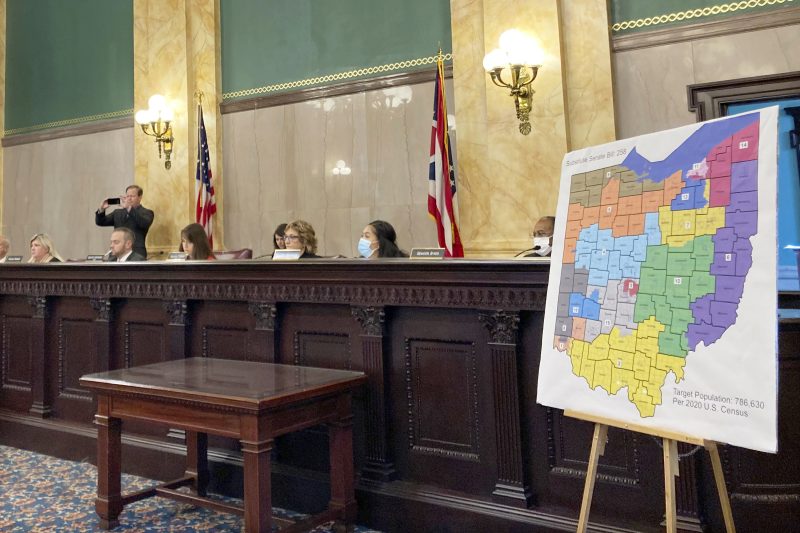The Ohio Supreme Court on Thursday dismissed two lawsuits challenging the state’s congressional map — which was ruled unconstitutional last year as favoring Republicans — clearing the way for the map to be used for next year’s elections.
The Democrats and voting rights advocates who filed the complaints last March had both requested on Tuesday that the Supreme Court dismiss their cases: Neiman v. LaRose and League of Women Voters of Ohio v. LaRose.
In the petition to have their cases dismissed, the plaintiffs wrote that, even if a newly redrawn map were to correct all of the deficiencies of the one used in 2022, it would be an expensive and lengthy process that would leave Ohio residents in limbo for at least several more months.
“For all of these reasons, given that the [2022 map] is at least a partial remedy, and given the substantial costs and uncertainty that further litigation would entail, Petitioners have decided to no longer pursue their challenge,” the plaintiffs wrote. “They strongly believe this is the best result under the circumstances for the people of Ohio who deserve certainty about the congressional map that they will be voting under in this cycle, at the very least.”
The petition to have their cases dismissed marked something of a tactical retreat for Democrats and voting rights groups in their lengthy battle against Ohio’s congressional maps. In 2018, Ohio voters passed a constitutional amendment to ban partisan gerrymandering. In November 2021, state Republican lawmakers proposed a new congressional map that the Ohio Supreme Court rejected as unconstitutional last January, saying the GOP under that map would have been favored to win 12 out of 15 seats in Ohio — a violation of the new anti-gerrymandering amendment.
The Republican-led Ohio Redistricting Commission then redrew the state’s congressional map in March 2022, but the Ohio Supreme Court struck down the second map last July as one that still unconstitutionally favored Republicans. Though it was still being litigated, that was the map used for the November 2022 congressional elections in Ohio, in which Democrats won five out of 15 seats.
David Niven, an associate professor of politics at the University of Cincinnati who has done research on gerrymandering, said it was likely that the plaintiffs withdrew their challenge to the 2022 map this week because it was “the least worst option.” He noted that Democrats were able to pick up a House seat in Ohio for the first time in more than a decade under the 2022 map, mostly because new anti-gerrymandering rules meant the redistricting commission could no longer split up Cincinnati into different districts.
“I think the concern was multiple bad possibilities: One was that this would ultimately produce a hostile court ruling that would empower even worse state legislative and congressional maps in the future,” Niven told The Washington Post. “And the other was, if the court actually did throw out the [2022] map, there was … no guarantee that [a new map] wouldn’t come back worse than it was.”
Regardless, under the anti-gerrymandering provision passed in 2018, Ohio’s congressional maps must be redrawn after 2024 no matter what, since the redistricting commission passed it without a bipartisan commitment. (A map that the commission passes with bipartisan support is good for 10 years, while those that do not receive bipartisan support are only good for four years.)
“That was meant to be a punishment if someone was being too partisan, but Republicans are probably happy to have a chance to redraw the maps” every four years, Niven said.
Jen Miller, executive director of the League of Women Voters of Ohio, said Thursday that voting rights advocates, including her group, were going to instead focus “on getting politicians and lobbyists completely out of the process” through a new citizen-led ballot initiative called “Citizens, Not Politicians.”
“Litigation is incredibly expensive and time consuming and doesn’t guarantee positive results for voters,” Miller told The Post. “We are also focused on advocating for fair and responsive Ohio Senate and Ohio House maps, which are extremely gerrymandered, but are also being redrawn.”
In a video posted to social media shortly after the Ohio Supreme Court dismissed the lawsuits, David Pepper, a former Democratic state party chairman, blasted the likelihood that Ohio would be voting in 2024 using a congressional map that had already been deemed unconstitutional.
“Ohioans will now, for the second two-year term, live within a congressional map that violates our current Ohio constitution,” Pepper said. “Four years in an unconstitutional map! I wish this was an isolated incident, Ohio, but it’s a pattern of just pure lawlessness and nonstop defiance of democracy in Ohio but also in other states.”
Colby Itkowitz contributed to this report.





























